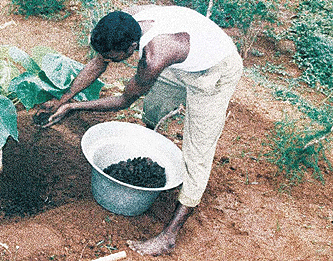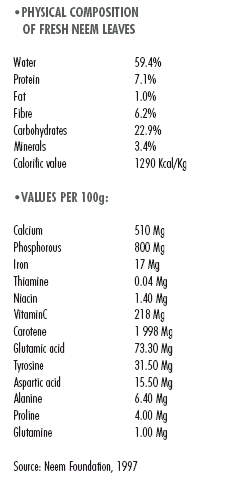 COUNTRY OF ORIGIN
COUNTRY OF ORIGINThe raincoat package for soil, plant, animal and human health
What problem does it solve?
The Raincoat Package covers multiple uses of the various parts of the Neem tree. It is suitable for use in developing countries because it is farm-based and cost-effective and can be replicated easily by farmers. The package belongs to an holistic tradition which involves healing the soil as well as people and plants; it has a wide range of activity and no side effects.
It promotes the use of Neem’s decorticated seed extract to combat many types of insects and pests. Field trials conducted at the Herbal Folklore Research Centre (HFRC) farm produced good results using Neem to fight the main pests attacking cabbage (caterpillar), eggplant (caterpillar, grasshoppers), red pepper (caterpillar), Ambretta (caterpillar, beetles) and major pests of Leguminosae and Cucurbitaceae. Use of the Raincoat Package stops further regeneration of the pests and inhibits larval development and spore germination of fungi.
Neem it is not harmful to the environment the way synthetic pesticides are: it deters pests without killing them. At the same time it is a source of food for useful insects like bees, and for birds. It also increases the presence of earth worms in the soil.
The Neem tree removes toxicity from unhealthy air, and its shade prevents the occurrence of many diseases. Areas where many Neem trees grow have lower incidences of malaria and fevers of diverse etiology. It is a long-held belief that Neem helps control environmental pollution.
Dry Neem leaves, when burned, emit smoke that serves as an insect repellent. This is an application used especially in rainy seasons when cattle and buffalo are bothered by large numbers of flies.
The Raincoat Package also includes methods for grain storage. The leftover Neem extract is used for controlling soil-borne pests, especially nematodes, and as bio-fertiliser to improve soil structure and enrich the plant nutrient base.
Finally, Neem is also useful for curing skin ailments in both human beings and animals. The Raincoat Package demonstrates its use in ways that can be easily adopted by farmers.
Neem has a bitter taste. The bitterness is due to an array of complex compounds called “ triterpenes” or more specifically “limonoids”. Nearly 100 protolimonoids, limonoids or tetranortriterpenoids and some nonterpinoid constituents have been isolated from various parts of the Neem tree (Jones et al., 1989; Koul et al, 1990) and others continue to be isolated. The most important bioactive principal is azadirachtin; at least ten other limonoids have properties that inhibit insect growth (Saxena, 1989; Schmutterer, 1990).
•IMPORTANT PHYTOCHEMICALS IN NEEM
The Neem tree has many unique compounds that have been identified, and others that are as yet unidentified. The identified compounds include:
•Nimbin – anti-inflammatory, anti-pyretic, antihistamine, anti fungal
•Nimbidin – antibacterial, anti-ulcer, antiarrhythmic, anti fungal
•Nimbidol – anti-tubercular, anti-protozoal, anti-pyretic
•Gedunin – vasodilator, anti-malarial, anti-fungal
•Sodium nimbinate – diuretic, spermicide, anti-arthritic
•Quercetin – antiprotozoal
•Salannin – repellent
•Azadirachtin – repellent, anti-feedant
DOWNLOAD THE BROCHURE PDF
english (0.7 MB)spanish (0.7 MB)
albanian (0.8 MB)
ONLY TEXT
•The raincoat package in practice







